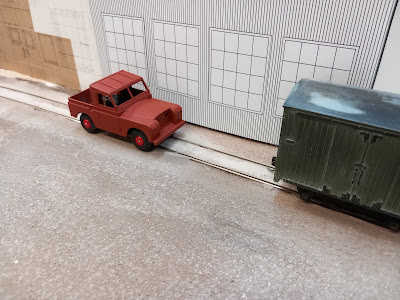Water tower and coal staithe.
General bits-and-pieces.
Geoff had continued with the water tower in the week and had completed the pipework and valve details. He'd also given it a base coat of black paint. It was fabulous.
The valve is chain operated (awaiting a loop of chain) and a length of rope or chain to swing the end of the delivery pipe in and out.
A small lump of XPS foam was carved and glued onto the staithe, before gluing grades of crushed coal over it.
Rust was then applied to the tank and a coat of grime applied to all of the timbers.
A final dusting of graphite was brushed over the staithe area to complete the scene.
Stephen had an easier week, as he worked through a series of small tasks:
Removing the cottages had caused some of the footpath to break away, and how to repair it was discussed.
Make doorsteps for the cottage front doors.
Glue the cottage fixing nuts in place. This will allow the interior detail of the derelict cottage to be completed.
Tidying up the various buildings, readying them for later over-cladding with embossed brickwork and corrugated sheeting.
Gluing down a factory sub-roof and applying stiffeners to the other roofs, ready for fixing down next week.
A perennial problem was also discussed, namely how products from the factory would be be packed and transported on the railway. Stephen had always envisaged pallets, but latterly, Geoff has insisted that pallets simply wouldn't have been significantly in use in 1963. He envisages crates being the main method, with a few items individually wrapped. The type of products was also discussed. What would the 'bread-and-butter' products be? We could only speculate: The full range of wall blocks for new and restored mansions, window lintel's and surrounds, ornamental features for houses and gardens, balustrades, capping's, balusters, copings for walls, gateways? He foresees most items being hand loaded and stacked on wagons rather than with forklift trucks loading palleted goods, but little evidence for either option has been found. We will need to agree a definitive list of products and packaging to ensure that we have some interesting and viable products on display.
The water panel was removed without any damage to the pile of stone waste, which will be further stabilised with PVA next week.































